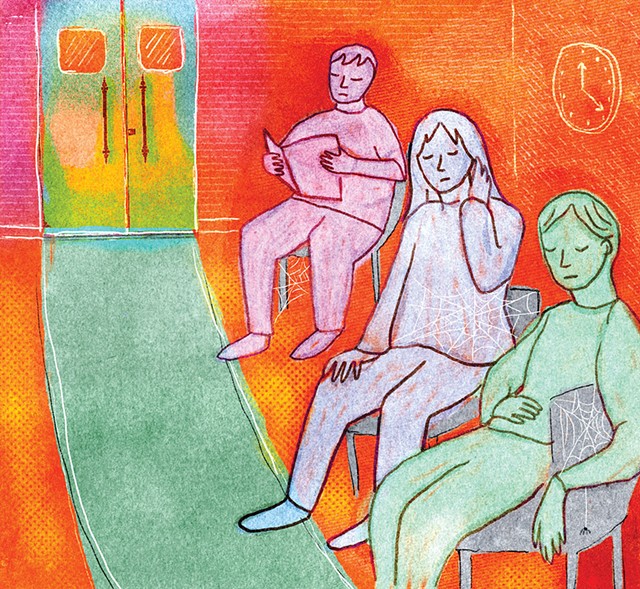Switch to the mobile version of this page.
Vermont's Independent Voice
- News
- Arts+Culture
- Home+Design
- Food
- Cannabis
- Music
- On Screen
- Events
- Jobs
- Obituaries
- Classifieds
- Personals
Browse News
Departments
Browse Arts + Culture
View All
local resources
Browse Food + Drink
View All
Browse Cannabis
View All
-
Culture

'Cannasations' Podcaster Kris Brown Aims to 'Humanize'…
-
True 802

A Burlington Cannabis Shop Plans to Host…
-
Business

Judge Tosses Burlington Cannabiz Owner's Lawsuit
-
Health + Fitness

Vermont's Cannabis Nurse Hotline Answers Health Questions…
-
Business

Waterbury Couple Buy Rare Vermont Cannabis License
Browse Music
View All
Browse On Screen
Browse Events
Browse Classifieds
Browse Personals
-

If you're looking for "I Spys," dating or LTRs, this is your scene.
View Profiles
Special Reports
Pubs+More
To Improve Medical Wait Times, Vermont First Has to Decide How to Measure Them
Published October 13, 2021 at 10:00 a.m.
Vermont Human Services Secretary Mike Smith announced in early September that his agency would investigate the problem of people being forced to wait months — and, in some cases, more than a year — to see physician specialists. A team of state officials and regulators has assembled in the weeks since, meeting regularly as it embarks on what will be Vermont's most comprehensive assessment of wait times ever.
The charge: Establish benchmarks for how long people should wait for medical care, collect data to find where backlogs exist, pinpoint the root causes and brainstorm solutions — all by the end of the year.
But before any of that can happen, investigators must first decide what, exactly, they need to measure. That could prove a surprisingly difficult task.
There's no agreed-upon standard for tracking patient wait times, and some of the more common metrics can fail to capture the true extent of the problem. There's also a dearth of existing data: Vermont regulators have only surveyed wait times at hospitals a few times over the last decade, and independent medical practices have never been included.
The pandemic's seismic disruption has only worsened matters. Officials hope the investigation will produce not only a diagnosis but also a treatment plan.
"This is an access problem," Smith said in an interview last week. "The longer you wait for access, the worse the health outcomes can be ... and the more expensive they become."
Medical wait times have long plagued parts of the United States, but comprehensive probes are rare. No organization routinely tracks wait times for medical appointments, and the data that is available has often come from one-off studies or media reports, making broad comparisons challenging.
A Seven Days cover story published last month cast light on the situation in Vermont, finding that patients can wait a year or more to see neurologists, urologists and other specialists at the state's largest hospital, the University of Vermont Medical Center. But the extent of the problem remains unclear. The state hopes to change that by including every Vermont physician in its assessment, regardless of whether they work for a hospital. Vermont had nearly 2,500 practicing physicians in 2018, according to a state survey that year.
"Before we can jump to problem solving, it's important that we understand where this happens," said Ena Backus, Vermont's director of health care reform, who's leading the investigation. "Is it system-wide? Is it certain regions of the state? Is it more likely to happen for some people than others, or some services versus others?
"The qualitative information — and our own experiences [of waiting] — really needs to be arrayed in a quantitative way," Backus said.
Backus' team is composed of officials from the Agency of Human Services, the Department of Financial Regulation and the Green Mountain Care Board, a powerful independent entity that regulates health care in Vermont. A pair of consulting firms — including Oliver Wyman, a New York City-based firm that has been providing the state's COVID-19 projections — will offer technical and research assistance.
The first question the team is grappling with is how to measure patient access across the state's entire health care system.
Individual practices often report wait times through the "third-next-available appointment" metric. The Institute for Healthcare Improvement, a Massachusetts-based nonprofit that advocates for more patient-centered health care systems, says that reporting the third open slot instead of the first offers a better reflection of availability. That's because cancellations can lead to earlier open slots and make a clinic's performance seem better than it is.
The Green Mountain Care Board asked Vermont hospitals to use this metric when reporting access data during this summer's budget cycle. Eleven of 14 hospitals reported their data in this format, and the results show backlogs for certain specialties are common across the state.
Neurology is the top offender; of the seven non-UVM Health Network hospitals that reported data for the specialty, five said their third-next-available appointment was at least two months out, with the longest wait at the Southwestern Vermont Medical Center (163 days), followed by Rutland Regional Medical Center (92 days).
Some experts are skeptical of the third-next-available appointment metric, noting that it only provides a snapshot into future availability, reveals nothing of recent performance and can be misleading.
Vizient, a national health care company based in Texas that works with hospitals to reduce their costs and improve their performance, encourages its members to track a different metric instead: the percentage of new patients who are seen within a certain time frame.
The UVM Medical Center, a longtime Vizient member, uses this metric with a goal to see 80 percent of new patients within two weeks. And so does the health network's two other hospitals in Vermont: Central Vermont Medical Center in Berlin and Porter Medical Center in Middlebury.
John Brumsted, CEO and president of the UVM Health Network, said he prefers the metric because it allows his hospitals to easily gauge their performance against Vizient's other members through the company's massive private database. (Hospitals are prohibited from sharing information about competitors publicly, and Vizient did not return a request for aggregated data.)
"The only metrics that are relevant to us are those that we can benchmark ourselves against other similar organizations," Brumsted said. Otherwise, he said, "we're just comparing ourselves to ourselves, which is a fool's errand."
Some, however, have questioned how UVM tracks patient access.
Jessica Holmes is a Middlebury economics professor and Green Mountain Care Board member who is participating in the wait times investigation. She said at a recent meeting that she suspects the health network underestimates the true problem at its hospitals because knowing that, say, 30 percent of patients got scheduled within two weeks "doesn't really tell us what happens to the other 70 percent of patients." She said the metric also likely fails to capture the experience of people who seek care but go elsewhere because the waits are too long — something she herself has done.
The health network's data was still concerning. New patients were seen within two weeks only 46 percent of the time at the UVM Medical Center, 56 percent of the time at Porter Medical Center and 37 percent of the time at Central Vermont Medical Center.
As they ponder what data to ask for, Vermont officials may be able to glean some lessons from their northern neighbors. In 2006, Canada began tracking wait times for five "priority" areas — eye surgery, cancer surgery, cardiac surgery, joint replacement and diagnostic imaging — to bring more transparency around the waiting that had by then become a defining and notorious characteristic of the nation's universal health care system.
Provinces report how many people sought treatment in each priority area and how long 50 percent of patients — the median — and 90 percent of patients waited. For instance, the latest report shows that half the patients seeking knee replacement surgery waited fewer than 197 days, while half waited at least that long. The 90th percentile clocked in at 405 days, meaning the other 10 percent of patients waited longer.
The country also established best-practice benchmarks that hospitals strive toward, such as completing 90 percent of hip or knee replacements within 26 weeks.
Backus, Vermont's investigative lead, said it was too soon to know what data her team will request from health care providers, but she doubted a single metric would suffice. No matter what measures are chosen, Backus said, uniformity will be key: All providers must report the same data or else the exercise will fail.
The state, not providers, will decide what to measure, she said.
After determining what data to collect, the state will next need to figure out how to obtain it.
Larger hospitals will have an easier time fulfilling any requests, since they have dedicated data teams. But workforce shortages at smaller hospitals extend to virtually every department, said Jeff Tieman, president and CEO of the Vermont Association of Hospitals and Health Systems. That includes data and analytics departments, "which may not be more than one or two people" for some hospitals, he added.
"Our hospitals will do everything they can to answer the agency's questions, because it's important information," Tieman said. "But we'll also hope that [the Agency of Human Services] will be understanding about limitations of the moment."
Susan Ridzon, the director of HealthFirst, an organization that represents Vermont's independent doctors, said much will depend on what the state asks for.
"I honestly don't know how or if our practices track this specifically," she said. "I could see it being a challenge to collect the data in any standardized way and in an administratively simple way."
She was less concerned with how her group of doctors would compare in the assessment: "The wait times at our practices are far shorter."
It's not clear what the state will do in the event that a health care provider is unable — or unwilling — to provide data. "We're going to need to cross that bridge if we come to it," Backus said. "If there are limitations in the information that can be collected, we'll have to note where."
The investigative team's final task will be to figure out what's driving the biggest backlogs — and what can be done. Smith, the human services secretary, hoped to have the work completed in time for lawmakers to take up any legislative recommendations when the session begins in January. "Is it workforce shortages? Is it IT challenges? Is it scheduling and managing appointments?" Smith asked. "I see the final report having all those elements in it."
Brumsted, the UVM Health Network leader, said he hopes the final report will help Vermonters understand three main points: Long wait times are a national problem; hiring more doctors isn't a silver bullet; and the hospitals in his network are accepting responsibility for their struggles.
"We're not blaming anybody," he said. "We know that it is a problem, and we're working really, really hard [to improve]."
The original print version of this article was headlined "How Long?"
Related Stories
Got something to say?
Send a letter to the editor
and we'll publish your feedback in print!
More By This Author
About The Author

Colin Flanders
Bio:
Colin Flanders is a political reporter at Seven Days, covering the Statehouse. He previously worked as a reporter at a group of Chittenden County weekly newspapers covering Essex, Milton and Colchester.
Colin Flanders is a political reporter at Seven Days, covering the Statehouse. He previously worked as a reporter at a group of Chittenden County weekly newspapers covering Essex, Milton and Colchester.
Speaking of...
-

A New UVM Medical Center Effort Seeks to Support Dementia Caregivers
Feb 7, 2024 -

Vermont Health Care Workers Are Grappling With Unprecedented Workplace Violence
Nov 15, 2023 -

Board ‘Taken Aback’ by Chief Murad’s Behavior at Hospital, but Clears Him of Misconduct
Oct 25, 2023 -

Murad Used ‘Menacing Tone’ and Threatened to ‘Cuff’ Surgeon, Complaint Says
Apr 11, 2023 -

UVM Medical Center Seeks Green Light to Build Surgery Center
Feb 10, 2023 - More »
Comments
Comments are closed.
From 2014-2020, Seven Days allowed readers to comment on all stories posted on our website. While we've appreciated the suggestions and insights, right now Seven Days is prioritizing our core mission — producing high-quality, responsible local journalism — over moderating online debates between readers.
To criticize, correct or praise our reporting, please send us a letter to the editor or send us a tip. We’ll check it out and report the results.
Online comments may return when we have better tech tools for managing them. Thanks for reading.
- 1. UVM, Middlebury College Students Set Up Encampments to Protest War in Gaza News
- 2. Dog Hiking Challenge Pushes Humans to Explore Vermont With Their Pups True 802
- 3. Scott Official Pushes Back on Former State Board of Ed Chair's Testimony Education
- 4. A Former MMA Fighter Runs a Wildlife Rehabilitation Center in Cabot News
- 5. Governor Makes Last-Minute Appeal to Delay Vote on Ed Secretary Nominee Education
- 6. Burlington Budget Deficit Balloons to $13.1 Million News
- 7. Home Is Where the Target Is: Suburban SoBu Builds a Downtown Neighborhood Real Estate
- 1. Totally Transfixed: A Rare Eclipse on a Bluebird Day Dazzled Crowds in Northern Vermont 2024 Solar Eclipse
- 2. Zoie Saunders, Gov. Scott’s Pick for Education Secretary, Faces Questions About Her Qualifications Education
- 3. Don't Trash Those Solar Eclipse Glasses! Groups Collect Them to Be Reused 2024 Solar Eclipse
- 4. State Will Build Secure Juvenile Treatment Center in Vergennes News
- 5. Vermont Awarded $62 Million in Federal Solar Incentives News
- 6. Queen of the City: Mulvaney-Stanak Sworn In as Burlington Mayor News
- 7. New Jersey Earthquake Is Felt in Vermont News















































